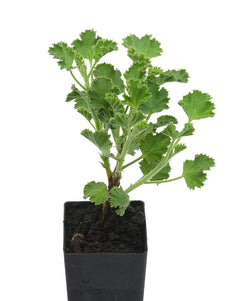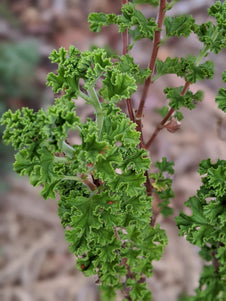



Scented Geranium Lime
Scented Geranium Lime

- In stock, ready to ship
- Inventory on the way

Usually available: April to November
Life cycle: Perennial
Height: 60 - 90cm
Position: Sun / part shade
Soil preference: Well drained
This is how we pack and send your Herb Plants to all states except TAS & WA
You will receive
- 1 Scented Geranium Lime Herb Plant in a 50 X 75mm tube - General growing instructions
All of our Herb Plants are grown organically with certified organic potting mixes and fertilizers
Botanical Name: Pelargonium X nervosum
Lime Scented Geranium is a vigorous, but small pelargonium growing from 60-90cm high and 45-60cm wide. The leaves are a darker green than most of the Scented Geraniums and they are held at symmetrically whorled positions around the stem. The stems are quite woody, so they are strong and upright in their growth habit. The aromatic leaves are quite small, round, smooth and slightly ruffled with serrated edges. The lavender flowers bloom in summer and are somewhat insignificant, although attractive. The upper petals have deep purple spots to distinguish them.
Lime Scented Geranium is a hybrid of P. nervosum, with the genus name ‘pelargonium’ which comes from the Greek word ‘pelargos’, meaning stork. This is a reference to the shape of the fruit which looks like a stork’s beak. Pelargoniums are called ‘storkbills’ in some areas of the United States. The species name is ‘nervosum’ which means ‘nerved’ in Latin, perhaps a reference to the relaxing effects of the fragrance on the nerves or anxiety. This ‘pelargonium-geranium’ should not be confused with the true Geranium nervosum which is native to North America.
This variety is said to be one of the strongest of the citrus Scented Geraniums with a sharp, astringent aroma. If planted near pathways, like all the Pelargoniums, walking past and brushing against the leaves will release the scent.
Pelargonium General Notes
Pelargoniums are evergreen perennials, sharing many common characteristics with the Geranium species. They range in height from 30- 100cm and may be categorized based on varying leaf shapes, such as crinkled, oak or fern leaf shapes. The leaf colour may vary from deep to light green, with flowers generally held in loose clusters. Most prefer to grow in full sun and they are also drought and heat tolerant. However, some varieties do require some shade and moist conditions where possible. Many grow near streams in their native habitats, but generally ‘less is more’ is a good guideline for watering these plants. They do not like to be damp at all.
This group of plants were initially catalogued by Linnaeus into the same Genus as Geraniums, but were separated into separate genera in 1789. Pelargoniums were taken to England in 1631, but it is likely they were transported to Holland in the earlier 1600’s. Since early times various varieties have been developed and many are now cultivated commercially for the essential oils used in perfumery and aromatherapy.
The Pelargonium genus is one of five in the family Geraniaceae, which has over 800 species. This includes the separate Geranium genus, which often causes confusion since ‘geranium’ is also used as a common name for the many Pelargonium species and cultivars. There is thought to be 270 species of Pelargonium, with 219 being native to South Africa. Among these, there is a number of genera or subtypes of pelargonium based on features such as leaf type. Of this selection about 80% are native only to select areas in the southern regions of South Africa. The remaining 20% are found in Australia, New Zealand and a few select areas such as Madagascar and Eastern Africa. There are now cultivated varieties all over the world, most with origins in South Africa. The true Geranium species is a hardy group of plants native to North America and Europe.
The Geranium plant family is an important food source for certain Lepidoptera species in their native regions. For more information on our other Scented Geranium listings.
Growing Conditions
Most pelargoniums enjoy full sun and Lime Scented Geranium is no exception with 6-8 hours of sunlight recommended. However, Pelargonium X nervosum may grow in either full sun or part shade. It requires a moist, but not damp environment, with well- drained soil. It is generally drought tolerant once established. Most soil types will be accepted and some organic matter or fertilizer may be useful. This plant is an untidy grower, so it should be pruned to help keep its shape and reduce the height as required.
This hybrid pelargonium is quite small, so it grows well in containers and hanging baskets. In cold regions it may even be taken indoors, but may be better treated as an annual if this is not possible. Although, not very tolerant of frost some plants may die down and return when the weather warms in spring. It may be propagated by tip or stem cuttings taken in autumn or spring.
Culinary Uses
Pelargoniums are usually suitable for culinary use, particularly the leaves and flowers. They may be used for herbal teas and to sweeten and scent desserts such as cakes and jelly. The most commonly used are those with rose, lemon and peppermint scents. Leaves may be cut and placed in ice cube trays for later use in iced tea or other suitable cold drinks. Lime Scented Geranium is said to have one of the strongest citrus scents, so this would lend itself to flavouring many food dishes.
A tea infusion may be made using 3 teaspoons of freshly chopped leaves, or 1 teaspoon of dried leaves, and 1 cup (250mls) of boiling water. Let the leaves steep, strain and then drink as needed. There are several varieties suitable for a tea infusion, but it may be a matter of taste.
Medicinal Uses
Many South African varieties of Pelargonium have a history of traditional medicine use by local tribes. General traditional use has included treatment for digestive and respiratory ailments, wounds, burns, ulcers and abscesses, cold sores and sore throats. The active chemicals are slightly astringent so they are good for skin care, oily skin and cleansing the pores. Overall the pelargonium species are seen as having value for creating a relaxing and uplifting feeling, while calming nerves, anxiety and aiding depression. There is also value for use in premenstrual tension and for those seeking an essential oil for creating a soothing and balancing effect on the body. Different varieties may have different effects.
The strongly scented Rose Scented Geranium, Pelargonium graveolens, is one of the best plants in this genus for traditional medicine use. Several active chemicals, in this species, have been determined to be beneficial for having antibiotic effects and nerve pain relief. Research has indicated it is helpful for nerve pain associated with shingles. It is thought to also have a soothing effect on the skin when used to bath rashes, skin irritations or simply used in bath water.Other Uses
Lime Scented Geranium and many of the scented pelargonium species and varieties are cultivated especially for their use in perfumery, aromatherapy and massage therapy. Rose Scented Geranium is often used as a substitute for Rose of Attar. The oil is extracted from the leaf and stems of the plant.
All information provided on this website is for informational purposes only. Please seek professional advice before commencing any treatment.





